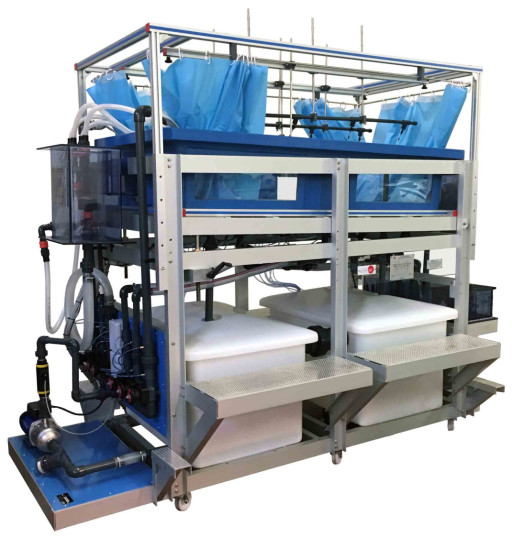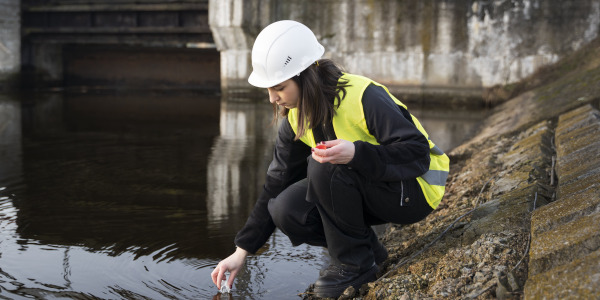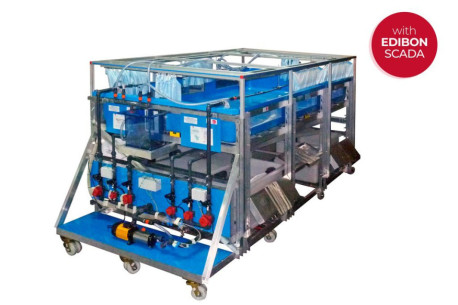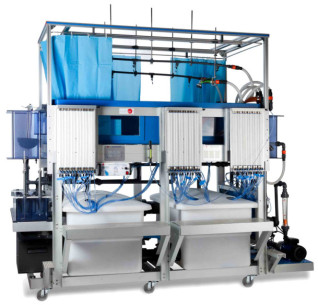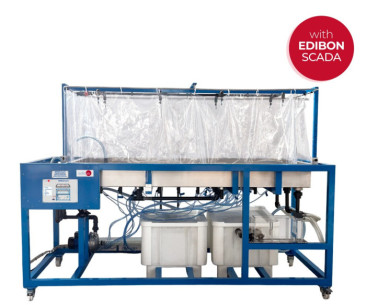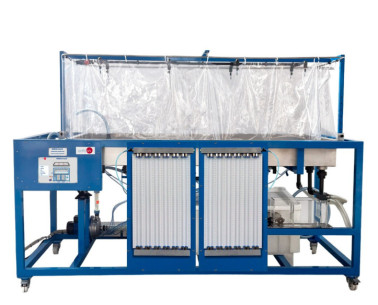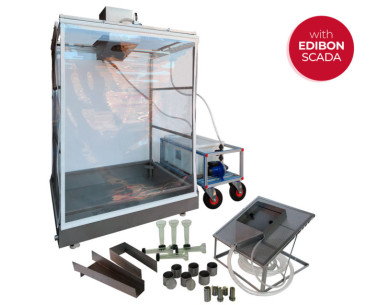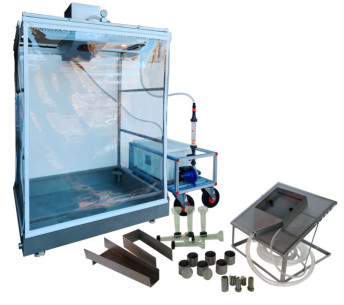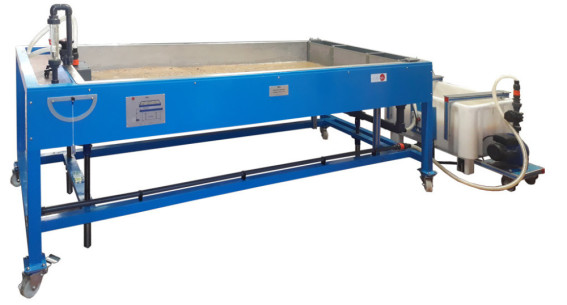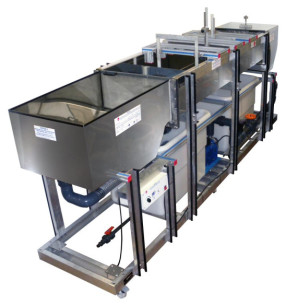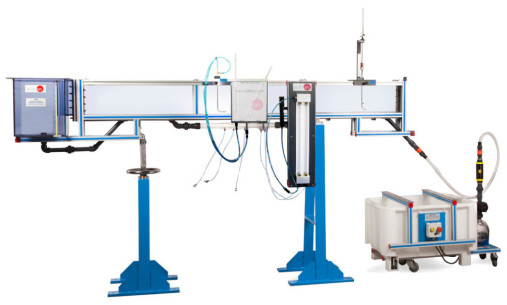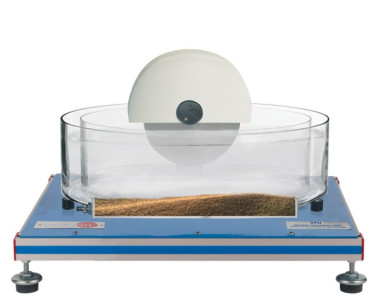ESHC(2x1m) Gerät für Hydrologische Systeme, Regensimulator und Bewässerungssysteme (2x1 m), computergesteuert (PC)
INNOVATIVE SYSTEME
The Computer Controlled Hydrologic Systems, Rain Simulator and Irrigation Systems Unit (2x1 m), "ESHC(2x1m)", is a self-contained unit designed to demonstrate some physical processes found in hydrology and fluvial geomorphology, including: rainfall hydrographs for catchment areas of varying permeability, the formation of rivers and their features and effects of sediment transport, the abstraction of ground water by drains, both with and without surface recharge from rainfall, etc.
Erweiterungen
Laboratorien
ÄHNLICHE NEUIGKEITEN
ALLGEMEINE BESCHREIBUNG
The Computer Controlled Hydrologic Systems, Rain Simulator and Irrigation Systems Unit (2x1 m), "ESHC(2x1m)", is a self-contained unit designed to demonstrate some physical processes found in hydrology and fluvial geomorphology, including: rainfall hydrographs for catchment areas of varying permeability, the formation of rivers and their features and effects of sediment transport, the abstraction of ground water by drains, both with and without surface recharge from rainfall, etc.
This unit allows demonstrating, on a small scale, the hydrological principles of ground water flow and the applications of these principles to some engineering constructions. Moreover, it allows to study the use of drains for water abstraction, de-watering and drainage of lakes, and demonstration of flood risks linked to land drainage works.
The main element of the unit is a test tank, which can be filled with sand and its tilt regulated by a lifting system. Water is supplied to the test tank through different systems: from two flexible separate hoses (simulating water inlets), from an inlet tank (simulating a river), from spray and showers nozzles located above the tank (simulating rain), or from french drains. Water is output from a river outlet tank, from the drainages located on two test tank corners, from the french drains, which have independent outlets, or from the overflows.
Two large plastic storage tanks are located under the test tank to store water.
A computer controlled pump with speed regulation impels water from the storage tanks to the test tank.
Two flexible separate hoses, placed at the test tank front side, allow adding great inlet flows.
In order to be able to simulate a river, the test tank has a tank attached to the inlet and other tank attached to the outlet. Gravel can be put inside the river inlet tank to deaden the flow and avoid turbulence. The use of a suitable channel section provides appropriate flow conditions in the test tank. The river outlet tank is located at the other end of the test tank and is used for hydrographs, run-off and river formation demonstrations.
The river tanks are communicated with the test tank through a floodgate that has two trap doors, a hermetic one and a meshed one.
Eight spray nozzles are mounted at a double line mobile bridge placed on the test tank and are arranged in a longitudinally equidistant way to provide an even water distribution along the test tank. These nozzles are also adjustable in height and width and can be easily fixed. Each nozzle has an associated ball valve, allowing a wide variety of moving rain precipitation patterns to be simulated.
Two shower nozzles with multiple flows are placed on the test tank and allow storms and local inputs simulation. These nozzles are also adjustable in height and length, and they can be separated from the support to move them manually.
The subsurface flow inputs are via two french drains, located in the middle of the test tank. These french drains extend the full width of the tank. Each french drain can be configured as an inlet or an outlet to permit a wide variety of hydrological demonstrations.
The outlet tank consists of a sediment collection basket.
So, it is possible to measure with a sensor the quantity of collected sediment over a period of time. There are three tanks at the rear part of the unit, each of them connected to one french drain and the other one connected to the drainages. Each one of these tanks has a spillway, which allows to calculate the outlet flow of each tank. The water flow in each tank is measured by a sensor. The outlet system (from french drains or drainages to tanks) includes three diaphragm valves to regulate the flow.
The test tank includes two overflows that are communicated with the storage tanks. The water table can be kept constant by means of these overflows, with adjustable height.
The flow of all the inlet systems can be regulated by a group of diaphragm valves located at the front side of the unit. There are five orifice plates and one flow sensor that allow measuring and control the water flow in each pipe of the inlet system. Other flow sensor is located at the outlet of the pump. Filters are included in the water supply lines, minimizing system disturbances.
The test tank includes 23 tapping points configured in a cruciform pattern. These 23 tapping points have two functions, depending on the position of the valves included. On the one hand, they are used to taking samples to chemically analyze the water at the twenty three points, a feature that allows to broaden the use of the unit to the study of drag and transport of fluvial polluting agents. On the other hand they are used with differential pressure sensors to measure and display the phreatic surface (or ground water table levels).
ÜBUNGEN UND GEFÜHRTE PRAKTIKEN
GEFÜHRTE PRAKTISCHE ÜBUNGEN IM HANDBUCH ENTHALTEN
- Determination of the surface drag.
- Determination of a hydrograph.
- Study of the hydrograph of one or several storms.
- Calculation of concentration time for a short storm.
- Determination of the compactness index.
- Determination of the drainage density.
- Obtaining of the pressure profile in a dike.
- Determination of the water obtained thanks to the gravity force and the field capacity.
- Study of fluvial-mechanical experiments.
- Formation and development of rivers over time.
- Study of sediment transport in models of rivers.
- Study of a meandering river.
- Study of the erosion on river beds and the speed of the flow.
- Study of groundwater catchment.
- Study of the cone of depression of a well.
- Study of the interaction of cones of depression by two adjoining wells.
- Study of a well in the center of a round island.
MEHR PRAKTISCHE ÜBUNGEN FÜR DAS GERÄT
- Study of the storm hydrograph of a previously saturated catchment.
- Study of the storm hydrograph of an impermeable catchment.
- Study of the effect of a moving storm on a flood hydrograph.
- Study of the effect of reservoir storage on a flood hydrograph.
- Study of the effect of drain pipes on a flood hydrograph.
- Investigation of stream flows modeled in alluvial material.
- Study of sediment transport, bedload motion, scour and erosion.
- Construction of drawdown curves for one well and two wells systems.
ÄHNLICHE VERFÜGBARE GERÄTE
Gerät für Hydrologische Systeme, Regensimulator und Bewässerungssysteme (2x1 m)
ERGÄNZENDE AUSRÜSTUNG
Gerät für Hydrologische Systeme, Regensimulator und Bewässerungssysteme (4x2 m), computergesteuert (PC)
Gerät für Hydrologische Systeme, Regensimulator und Bewässerungssysteme (2x1 m)
Gerät für Hydrologische Studien, computergesteuert (PC)
Gerät für Hydrologische Studien
Gerät zur Erstellung von Niederschlagshydrographen
Regensimulator für Bodenerosionsstudien, computergesteuert (PC)
Regensimulator für Bodenerosionsstudien
Fluss-Simulator für Flüsse
Gerät zur Visualisierung von Strömung und beweglichem Bett (Arbeitsbereich: 2000X610 mm)
Gerät zur Visualisierung von Strömung und beweglichem Bett (Arbeitsbereich: 4000X610 mm)
Offener Sedimentationskanal
Gerät für den Transport von Sedimenten
QUALITÄT

KUNDENDIENST

 Cookie-Präferenzen
Cookie-Präferenzen

